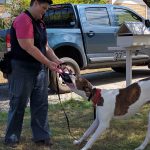Preventing Separation Anxiety
As pandemic-related restrictions continue to relax in NSW, life returns to a new normal… with a new puppy or dog now facing time at home, alone. Understandably, we want to transition as smoothly as possible to make sure we prevent separation anxiety.

What is separation anxiety? There is no one definition. It is often a number of separation-related behaviours indicating signs of extreme distress, basically a panic attack, When left alone or as you are preparing to leave.
Separation-related behaviours include:
- Inappropriate toileting
- Excessive barking, howling, whining, and other vocalisations
- Pacing, panting, drooling, trembling
- Not eating
- Destruction of property like digging & chewing, often at potential escape points like doors or windows
- Self-soothing behaviours like excessive licking to the point of self-harm
- Self-injury caused by prolonged attempts to escape
Note: Some of these behaviours can be normal depending on context, or have other causes. It is always recommended to rule out anything medical if you have concerns.
We can do stuff to reduce the chances of these behaviours manifesting and separation anxiety occurring. While some of these strategies would be best to do from early puppyhood, we can also reduce the chances & symptoms in older dogs. Start now.
- Set a routine. I’m not talking down to the minute, it’s the order of events that seem to matter to our dogs so focus on that. Dogs are amazing at picking up patterns*, and having a routine makes life more predictable. More predictable is less stressful.
- Your routine should include periods of confinement. Pick where your dog will hang out when you are out and/or sleep, like a crate, pen, area of the verandah or yard, and get them used to being in that space. Sometimes with you, and increasingly longer without you (both duration & distance). Even if you provide a potty or access to outside, it is good practice to toilet first too.
- The periods of confinement should include safe stuff to do. Something to sniff out, a licky mat, puzzle feeding toys, homemade enrichment puzzles, a bone or long-lasting chew, can all keep your dog distracted while they spend some time alone.
- Use training to support your dog through this. Label what you are doing to reinforce that predictability, but make your leaving as uneventful as possible. For example, “outside” might mean time to go out on the deck, and you go back inside to your home office without fanfare.
- Avoid responding to vocalisations. It’s normal for a dog to have a little whinge when their source of fun leaves them alone, so avoid responding to it as much as you can. If the vocalisation is true distress, you have progressed to far too soon (maybe your distance or duration is too long), so go back a step.
- Your routine should include exercise. Make sure you are doing age-appropriate activities for physical and mental exercise. Regular walkies, structured play, and training sessions are important to set you up for success.
- Medications & supplements may assist. Calming supplements like Rescue Remedy, Valerian, Adaptil, and Zylkene may help, at least to assist deeper training if required. Extreme cases may need medications that will need to be prescribed by a vet.
- Tools may also assist. Sounds like talkback radio, classical music or even specialised radio for dogs may assist to calm or fill the silence for your dog. Specialised compression garments (like Thundershirt) or wraps also assist some dogs with anxiety behaviours.
*A word of caution: sometimes it’s that ability to pick up patterns that can see dogs starting to worry before we even leave. Just like you put on your sneakers before a walk, there is a string of behaviours we do that cues our dogs we are leaving and leaving without them. If you find this happens with your dog, please break your own pattern and then leave them alone for short periods only. If you have done the work that being alone is no big deal, and make your departure and arrival as uneventful as possible, this should start to be less of an issue.
A big thing is to set yourself up for success! I know leaving them gives us anxiety too, and we do have to be mindful that our dogs are awesome at picking up our feelings too. We can inadvertently project onto them, so we must make sure we breathe, and do the work. Don’t push for too long too soon.
And if you are doing all this and feel you are not making progress, please reach out for help. Some trainers like Ness Jones specialise in separation anxiety and can help! Ness also has a podcast called Tails from the Dog House.

 Previous Post
Previous Post Next Post
Next Post
